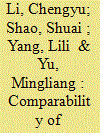|
|
|
Sort Order |
|
|
|
Items / Page
|
|
|
|
|
|
|
| Srl | Item |
| 1 |
ID:
150894


|
|
|
|
|
| Summary/Abstract |
Du and Lin (2015) argued that the estimation model of the economy-wide energy rebound effect proposed by Shao et al. (2014) should be revised and provided an alternative approach, which they considered to be more consistent with the definition of the rebound effect. However, in this comment, we do not find a valid correction or modification to our original model, because their criticism logic does not originate from the corresponding mechanism in Shao et al. (2014), and their estimation formula has a different benchmark with ours. Moreover, their data samples were also different from ours, generating the incomparable results, and there are some irrational results in the comment. Even based on different estimation formulas in the two studies and using the same estimation method and data sample, the comparison results show that the problem of the estimation formula in our previous study which they claimed does not really exist. We argue that this comment is not consistent with the principle of the rebound effect. Actually, their work can be only regarded as proposing an alternative approach for the estimate of the rebound effect. Therefore, their argument is not enough to overturn our previous study.
|
|
|
|
|
|
|
|
|
|
|
|
|
|
|
|
| 2 |
ID:
109688


|
|
|
|
|
| Publication |
2011.
|
| Summary/Abstract |
This paper estimates energy-related industrial CO2 emissions (ICE) in Shanghai from 1994 to 2009 and summarizes ICE's characteristics. The results show that the coal-type consumption is the ICE's largest source of the entire industry and that the energy consumption structure of CO2 emissions of the entire industry depends largely on that of six sub-sectors of high emission group, which contributes to most of ICE. Furthermore, the paper implements an econometric study on the ICE's determinants based on the ICE-STIRPAT model. The results indicate that the relationship between ICE and per capita output presents an inverted N-shaped curve with two turning points, resulting from the comprehensive influence of scale, composition, and technique effects, and that most sub-sectors remain in the second stage of the curve. Energy efficiency exerts a more efficient control over ICE than R&D intensity. ICE intensity is regulated more easily than ICE scale. In the long run, industrial growth and coal-type consumption play the most important roles in driving ICE, whereas energy efficiency exerts the most prominent effect on reducing it. The results of the robustness analysis indicate that the utilization of the ICE-STIRPAT model is valid and robust under the setting of environment impact control over ICE in Shanghai.
|
|
|
|
|
|
|
|
|
|
|
|
|
|
|
|
| 3 |
ID:
132615


|
|
|
|
|
| Publication |
2014.
|
| Summary/Abstract |
The energy rebound effect has been a significant issue in China, which is undergoing economic transition, since it reflects the effectiveness of energy-saving policy relying on improved energy efficiency. Based on the IPAT equation and Brookes× explanation of the rebound effect, this paper develops an alternative estimation model of the rebound effect. By using the estimation model and latent variable approach, which is achieved through a time-varying coefficient state space model, we estimate China×s economy-wide energy rebound effect over 1954-2010. The results show that the rebound effect evidently exists in China as a result of the annual average of 39.73% over 1954-2010. Before and after the implementation of China×s reform and opening-up policy in 1978, the rebound effects are 47.24% and 37.32%, with a strong fluctuation and a circuitously downward trend, respectively, indicating that a stable political environment and the development of market economy system facilitate the effectiveness of energy-saving policy. Although the energy-saving effect of improving energy efficiency has been partly realised, there remains a large energy-saving potential in China.
|
|
|
|
|
|
|
|
|
|
|
|
|
|
|
|
|
|
|
|
|